seat adjustment SKODA ROOMSTER 2012 1.G Owner's Manual
[x] Cancel search | Manufacturer: SKODA, Model Year: 2012, Model line: ROOMSTER, Model: SKODA ROOMSTER 2012 1.GPages: 194, PDF Size: 4.8 MB
Page 6 of 194
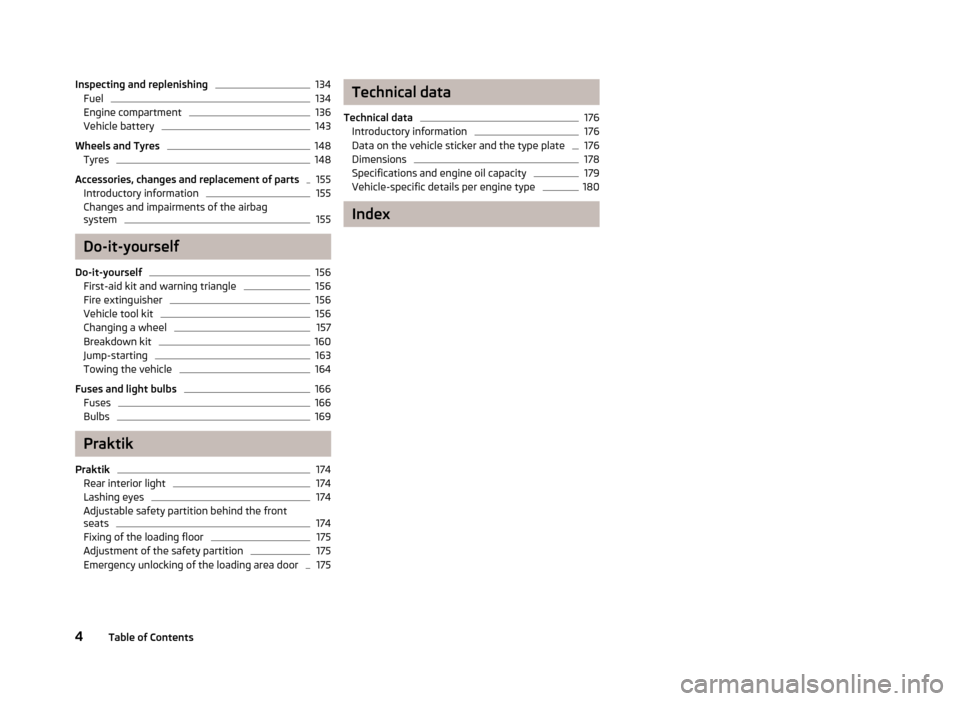
Inspecting and replenishing 134
Fuel 134
Engine compartment 136
Vehicle battery 143
Wheels and Tyres 148
Tyres 148
Accessories, changes and replacement of parts 155
Introductory information 155
Changes and impairments of the airbag
system 155
Do-it-yourself
Do-it-yourself 156
First-aid kit and warning triangle 156
Fire extinguisher 156
Vehicle tool kit 156
Changing a wheel 157
Breakdown kit 160
Jump-starting 163
Towing the vehicle 164
Fuses and light bulbs 166
Fuses 166
Bulbs 169
Praktik
Praktik 174
Rear interior light 174
Lashing eyes 174
Adjustable safety partition behind the front
seats 174
Fixing of the loading floor 175
Adjustment of the safety partition 175
Emergency unlocking of the loading area door 175 Technical data
Technical data 176
Introductory information 176
Data on the vehicle sticker and the type plate 176
Dimensions 178
Specifications and engine oil capacity 179
Vehicle-specific details per engine type 180
Index
4 Table of Contents
Page 9 of 194
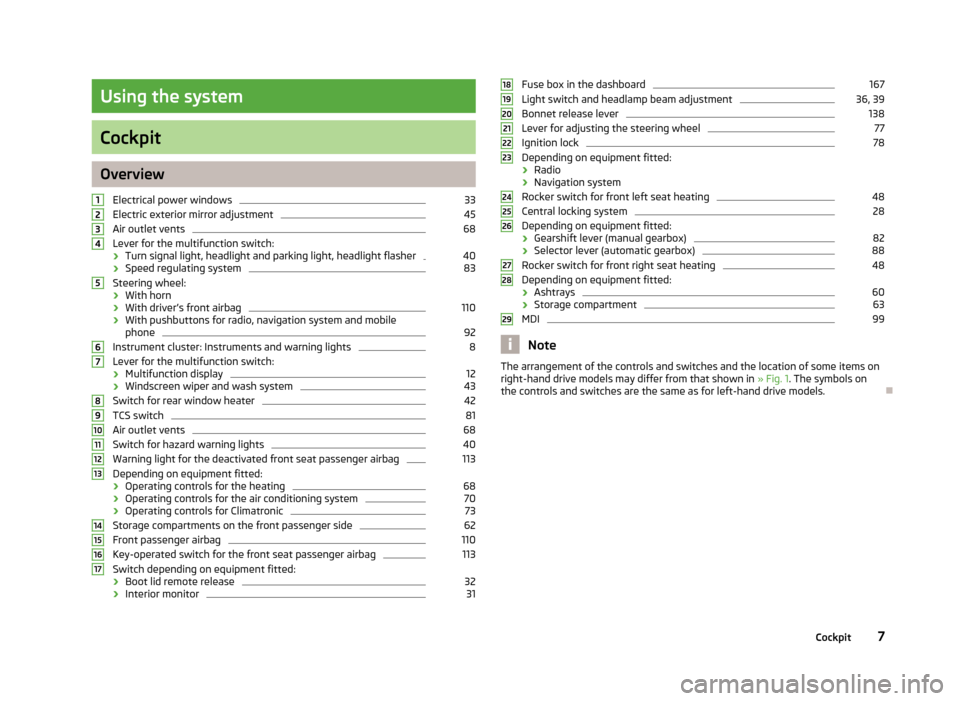
Using the system
Cockpit
Overview
Electrical power windows 33
Electric exterior mirror adjustment 45
Air outlet vents 68
Lever for the multifunction switch:
› Turn signal light, headlight and parking light, headlight flasher 40
› Speed regulating system 83
Steering wheel:
› With horn
› With driver’s front airbag 110
› With pushbuttons for radio, navigation system and mobile
phone 92
Instrument cluster: Instruments and warning lights 8
Lever for the multifunction switch:
› Multifunction display 12
› Windscreen wiper and wash system 43
Switch for rear window heater 42
TCS switch 81
Air outlet vents 68
Switch for hazard warning lights 40
Warning light for the deactivated front seat passenger airbag 113
Depending on equipment fitted:
› Operating controls for the heating 68
› Operating controls for the air conditioning system 70
› Operating controls for Climatronic 73
Storage compartments on the front passenger side 62
Front passenger airbag 110
Key-operated switch for the front seat passenger airbag 113
Switch depending on equipment fitted:
› Boot lid remote release 32
› Interior monitor 311
2
3
4
5
6
7
8
9
10
11
12
13
14
15
16
17 Fuse box in the dashboard 167
Light switch and headlamp beam adjustment 36, 39
Bonnet release lever 138
Lever for adjusting the steering wheel 77
Ignition lock 78
Depending on equipment fitted:
› Radio
› Navigation system
Rocker switch for front left seat heating 48
Central locking system 28
Depending on equipment fitted:
› Gearshift lever (manual gearbox) 82
› Selector lever (automatic gearbox) 88
Rocker switch for front right seat heating 48
Depending on equipment fitted:
› Ashtrays 60
› Storage compartment 63
MDI 99
Note
The arrangement of the controls and switches and the location of some items on
right-hand drive models may differ from that shown in »
Fig. 1. The symbols on
the controls and switches are the same as for left-hand drive models. Ð 18
19
20
21
22
23
24
25
26
27
28
29
7
Cockpit
Page 41 of 194
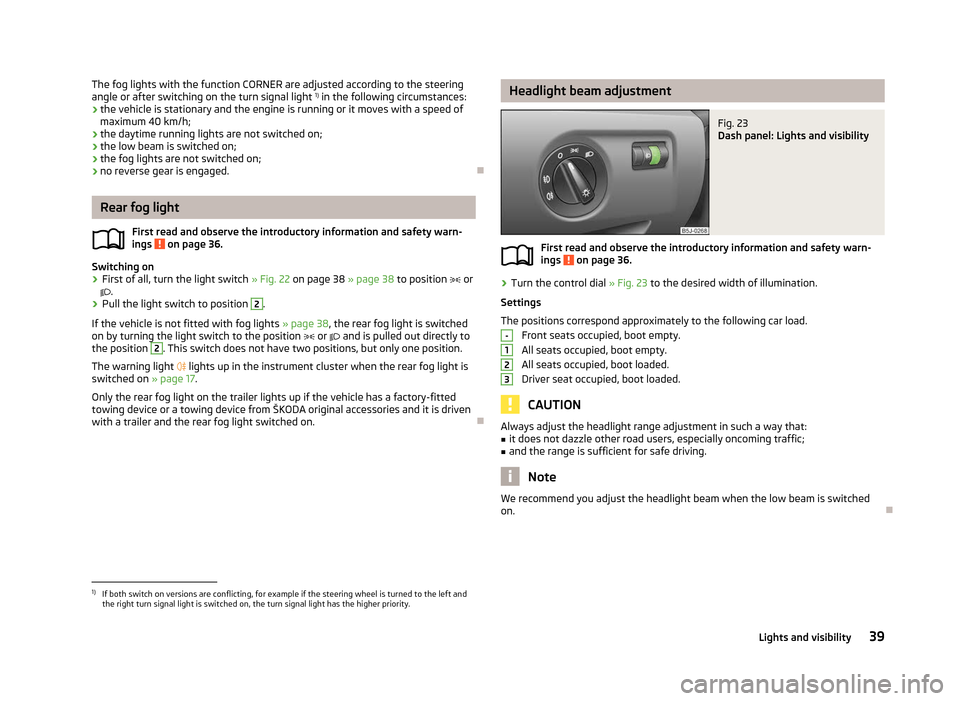
The fog lights with the function CORNER are adjusted according to the steering
angle or after switching on the turn signal light
1)
in the following circumstances:
› the vehicle is stationary and the engine is running or it moves with a speed of
maximum 40 km/h;
› the daytime running lights are not switched on;
› the low beam is switched on;
› the fog lights are not switched on;
› no reverse gear is engaged. ÐRear fog light
First read and observe the introductory information and safety warn-
ings on page 36.
Switching on
› First of all, turn the light switch
» Fig. 22 on page 38 » page 38 to position or
.
› Pull the light switch to position 2
.
If the vehicle is not fitted with fog lights » page 38, the rear fog light is switched
on by turning the light switch to the position or and is pulled out directly to
the position 2
. This switch does not have two positions, but only one position.
The warning light
lights up in the instrument cluster when the rear fog light is
switched on » page 17.
Only the rear fog light on the trailer lights up if the vehicle has a factory-fitted
towing device or a towing device from ŠKODA original accessories and it is driven
with a trailer and the rear fog light switched on. Ð
ä Headlight beam adjustment
Fig. 23
Dash panel: Lights and visibility
First read and observe the introductory information and safety warn-
ings on page 36.
›
Turn the control dial
» Fig. 23 to the desired width of illumination.
Settings
The positions correspond approximately to the following car load. Front seats occupied, boot empty.
All seats occupied, boot empty.
All seats occupied, boot loaded.
Driver seat occupied, boot loaded. CAUTION
Always adjust the headlight range adjustment in such a way that:
■ it does not dazzle other road users, especially oncoming traffic;
■ and the range is sufficient for safe driving. Note
We recommend you adjust the headlight beam when the low beam is switched
on. Ð
ä -
1
2
3
1)
If both switch on versions are conflicting, for example if the steering wheel is turned to the left and
the right turn signal light is switched on, the turn signal light has the higher priority.
39
Lights and visibility
Page 49 of 194
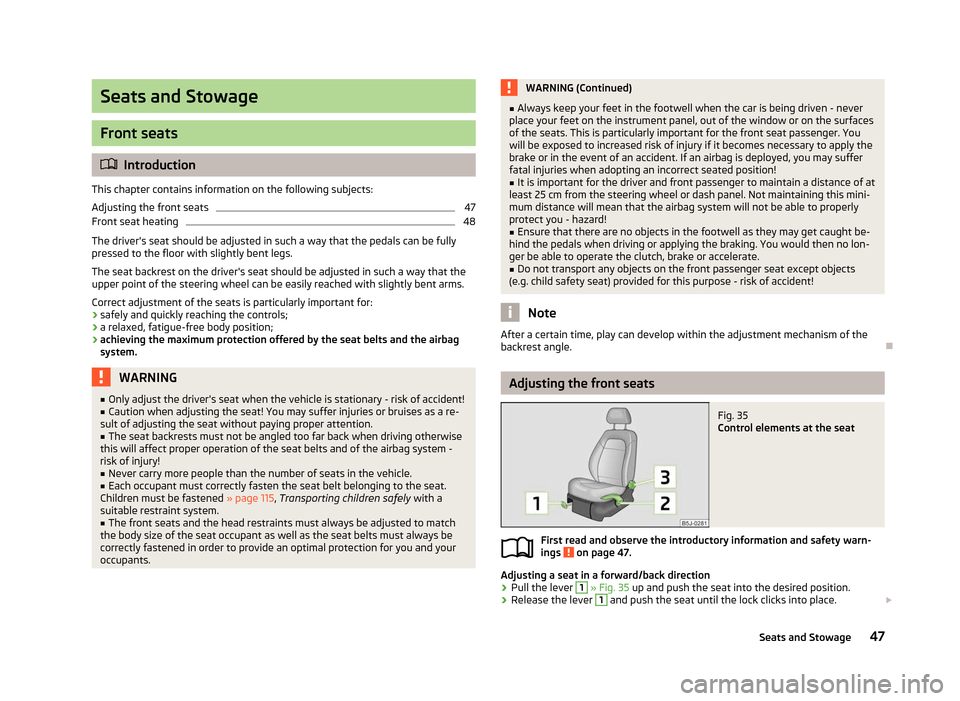
Seats and Stowage
Front seats
ä
Introduction
This chapter contains information on the following subjects:
Adjusting the front seats 47
Front seat heating 48
The driver's seat should be adjusted in such a way that the pedals can be fully
pressed to the floor with slightly bent legs.
The seat backrest on the driver's seat should be adjusted in such a way that the
upper point of the steering wheel can be easily reached with slightly bent arms.
Correct adjustment of the seats is particularly important for:
› safely and quickly reaching the controls;
› a relaxed, fatigue-free body position;
› achieving the maximum protection offered by the seat belts and the airbag
system. WARNING
■ Only adjust the driver's seat when the vehicle is stationary - risk of accident!
■ Caution when adjusting the seat! You may suffer injuries or bruises as a re-
sult of adjusting the seat without paying proper attention. ■ The seat backrests must not be angled too far back when driving otherwise
this will affect proper operation of the seat belts and of the airbag system -
risk of injury! ■ Never carry more people than the number of seats in the vehicle.
■ Each occupant must correctly fasten the seat belt belonging to the seat.
Children must be fastened » page 115, Transporting children safely with a
suitable restraint system.
■ The front seats and the head restraints must always be adjusted to match
the body size of the seat occupant as well as the seat belts must always be
correctly fastened in order to provide an optimal protection for you and your
occupants. WARNING (Continued)
■ Always keep your feet in the footwell when the car is being driven - never
place your feet on the instrument panel, out of the window or on the surfaces
of the seats. This is particularly important for the front seat passenger. You
will be exposed to increased risk of injury if it becomes necessary to apply the
brake or in the event of an accident. If an airbag is deployed, you may suffer
fatal injuries when adopting an incorrect seated position!
■ It is important for the driver and front passenger to maintain a distance of at
least 25 cm from the steering wheel or dash panel. Not maintaining this mini-
mum distance will mean that the airbag system will not be able to properly
protect you - hazard!
■ Ensure that there are no objects in the footwell as they may get caught be-
hind the pedals when driving or applying the braking. You would then no lon-
ger be able to operate the clutch, brake or accelerate.
■ Do not transport any objects on the front passenger seat except objects
(e.g. child safety seat) provided for this purpose - risk of accident! Note
After a certain time, play can develop within the adjustment mechanism of the
backrest angle. Ð Adjusting the front seats
Fig. 35
Control elements at the seat
First read and observe the introductory information and safety warn-
ings on page 47.
Adjusting a seat in a forward/back direction
›
Pull the lever 1
» Fig. 35 up and push the seat into the desired position.
› Release the lever 1
and push the seat until the lock clicks into place.
£
ä
47
Seats and Stowage
Page 104 of 194
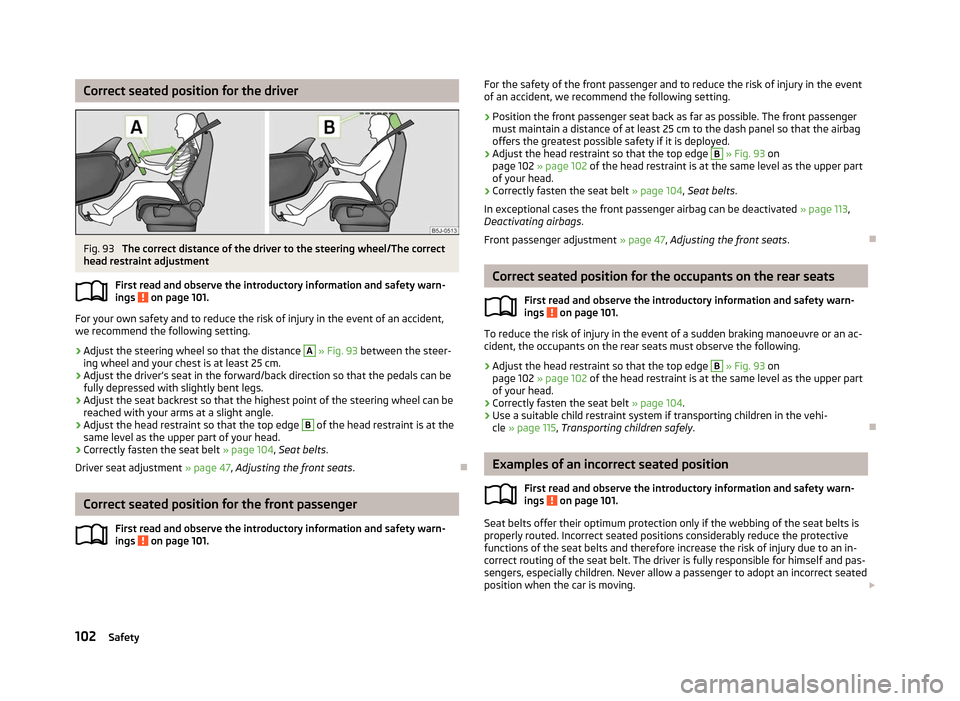
Correct seated position for the driver
Fig. 93
The correct distance of the driver to the steering wheel/The correct
head restraint adjustment
First read and observe the introductory information and safety warn-
ings on page 101.
For your own safety and to reduce the risk of injury in the event of an accident,
we recommend the following setting.
› Adjust the steering wheel so that the distance A
» Fig. 93 between the steer-
ing wheel and your chest is at least 25 cm.
› Adjust the driver’s seat in the forward/back direction so that the pedals can be
fully depressed with slightly bent legs.
› Adjust the seat backrest so that the highest point of the steering wheel can be
reached with your arms at a slight angle.
› Adjust the head restraint so that the top edge B
of the head restraint is at the
same level as the upper part of your head.
› Correctly fasten the seat belt
» page 104, Seat belts.
Driver seat adjustment » page 47, Adjusting the front seats .ÐCorrect seated position for the front passenger
First read and observe the introductory information and safety warn-
ings on page 101.ä
ä For the safety of the front passenger and to reduce the risk of injury in the event
of an accident, we recommend the following setting.
› Position the front passenger seat back as far as possible. The front passenger
must maintain a distance of at least 25
cm to the dash panel so that the airbag
offers the greatest possible safety if it is deployed.
› Adjust the head restraint so that the top edge B
» Fig. 93 on
page 102 » page 102 of the head restraint is at the same level as the upper part
of your head.
› Correctly fasten the seat belt
» page 104, Seat belts.
In exceptional cases the front passenger airbag can be deactivated » page 113,
Deactivating airbags .
Front passenger adjustment » page 47, Adjusting the front seats .Ð Correct seated position for the occupants on the rear seats
First read and observe the introductory information and safety warn-
ings on page 101.
To reduce the risk of injury in the event of a sudden braking manoeuvre or an ac-
cident, the occupants on the rear seats must observe the following.
› Adjust the head restraint so that the top edge B
» Fig. 93 on
page 102 » page 102 of the head restraint is at the same level as the upper part
of your head.
› Correctly fasten the seat belt
» page 104.
› Use a suitable child restraint system if transporting children in the vehi-
cle » page 115, Transporting children safely .Ð Examples of an incorrect seated position
First read and observe the introductory information and safety warn-
ings on page 101.
Seat belts offer their optimum protection only if the webbing of the seat belts is
properly routed. Incorrect seated positions considerably reduce the protective
functions of the seat belts and therefore increase the risk of injury due to an in-
correct routing of the seat belt. The driver is fully responsible for himself and pas-
sengers, especially children. Never allow a passenger to adopt an incorrect seated
position when the car is moving.
£
ä
ä
102 Safety
Page 114 of 194
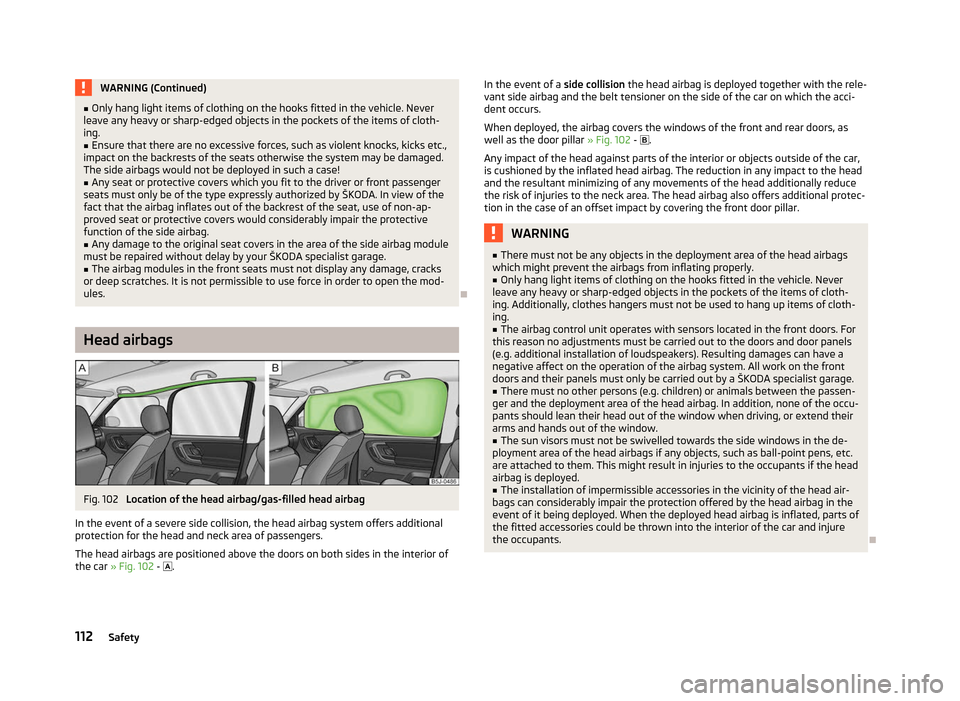
WARNING (Continued)
■ Only hang light items of clothing on the hooks fitted in the vehicle. Never
leave any heavy or sharp-edged objects in the pockets of the items of cloth-
ing.
■ Ensure that there are no excessive forces, such as violent knocks, kicks etc.,
impact on the backrests of the seats otherwise the system may be damaged.
The side airbags would not be deployed in such a case!
■ Any seat or protective covers which you fit to the driver or front passenger
seats must only be of the type expressly authorized by ŠKODA. In view of the
fact that the airbag inflates out of the backrest of the seat, use of non-ap-
proved seat or protective covers would considerably impair the protective
function of the side airbag.
■ Any damage to the original seat covers in the area of the side airbag module
must be repaired without delay by your
ŠKODA specialist garage.
■ The airbag modules in the front seats must not display any damage, cracks
or deep scratches. It is not permissible to use force in order to open the mod-
ules. ÐHead airbags
Fig. 102
Location of the head airbag/gas-filled head airbag
In the event of a severe side collision, the head airbag system offers additional
protection for the head and neck area of passengers.
The head airbags are positioned above the doors on both sides in the interior of
the car » Fig. 102 -
. In the event of a
side collision the head airbag is deployed together with the rele-
vant side airbag and the belt tensioner on the side of the car on which the acci-
dent occurs.
When deployed, the airbag covers the windows of the front and rear doors, as
well as the door pillar » Fig. 102 - .
Any impact of the head against parts of the interior or objects outside of the car,
is cushioned by the inflated head airbag. The reduction in any impact to the head
and the resultant minimizing of any movements of the head additionally reduce
the risk of injuries to the neck area. The head airbag also offers additional protec-
tion in the case of an offset impact by covering the front door pillar. WARNING
■ There must not be any objects in the deployment area of the head airbags
which might prevent the airbags from inflating properly.
■ Only hang light items of clothing on the hooks fitted in the vehicle. Never
leave any heavy or sharp-edged objects in the pockets of the items of cloth-
ing. Additionally, clothes hangers must not be used to hang up items of cloth-
ing.
■ The airbag control unit operates with sensors located in the front doors. For
this reason no adjustments must be carried out to the doors and door panels
(e.g. additional installation of loudspeakers). Resulting damages can have a
negative affect on the operation of the airbag system. All work on the front
doors and their panels must only be carried out by a
ŠKODA specialist garage.
■ There must no other persons (e.g. children) or animals between the passen-
ger and the deployment area of the head airbag. In addition, none of the occu-
pants should lean their head out of the window when driving, or extend their
arms and hands out of the window.
■ The sun visors must not be swivelled towards the side windows in the de-
ployment area of the head airbags if any objects, such as ball-point pens, etc.
are attached to them. This might result in injuries to the occupants if the head
airbag is deployed.
■ The installation of impermissible accessories in the vicinity of the head air-
bags can considerably impair the protection offered by the head airbag in the
event of it being deployed. When the deployed head airbag is inflated, parts of
the fitted accessories could be thrown into the interior of the car and injure
the occupants. Ð
112 Safety
Page 169 of 194
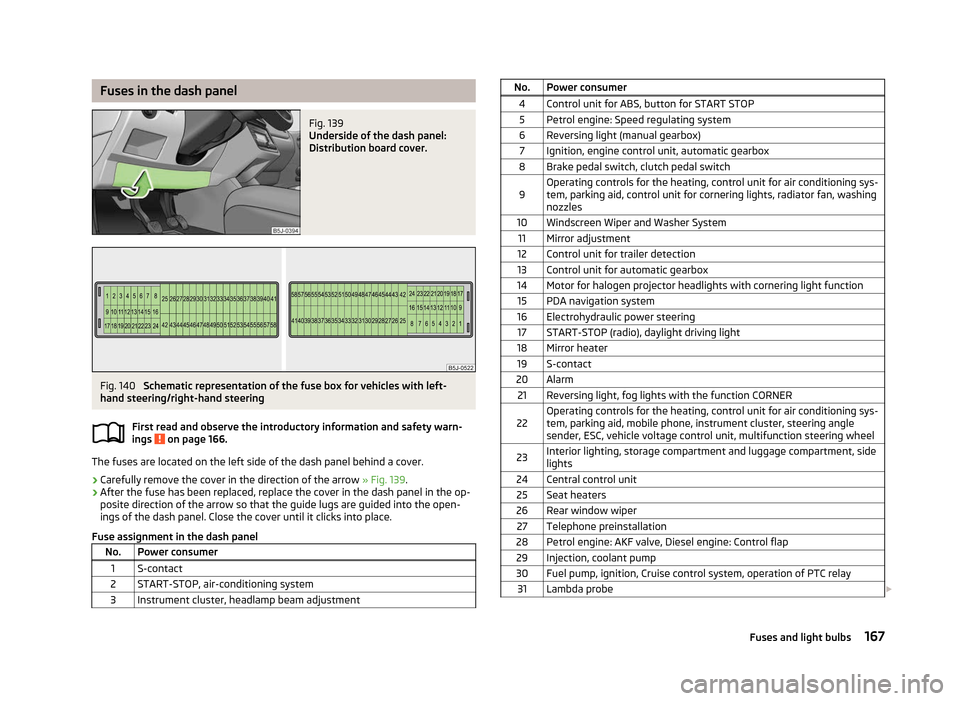
Fuses in the dash panel
Fig. 139
Underside of the dash panel:
Distribution board cover. Fig. 140
Schematic representation of the fuse box for vehicles with left-
hand steering/right-hand steering
First read and observe the introductory information and safety warn-
ings on page 166.
The fuses are located on the left side of the dash panel behind a cover.
›
Carefully remove the cover in the direction of the arrow
» Fig. 139.
› After the fuse has been replaced, replace the cover in the dash panel in the op-
posite direction of the arrow so that the guide lugs are guided into the open-
ings of the dash panel. Close the cover until it clicks into place.
Fuse assignment in the dash panel No. Power consumer
1 S-contact
2 START-STOP, air-conditioning system
3 Instrument cluster, headlamp beam adjustment ä No. Power consumer
4 Control unit for ABS, button for START STOP5 Petrol engine: Speed regulating system
6 Reversing light (manual gearbox) 7 Ignition, engine control unit, automatic gearbox
8 Brake pedal switch, clutch pedal switch
9 Operating controls for the heating, control unit for air conditioning sys-
tem, parking aid, control unit for cornering lights, radiator fan, washing
nozzles
10 Windscreen Wiper and Washer System 11 Mirror adjustment
12 Control unit for trailer detection
13 Control unit for automatic gearbox
14 Motor for halogen projector headlights with cornering light function 15 PDA navigation system
16 Electrohydraulic power steering 17 START-STOP (radio), daylight driving light
18 Mirror heater 19 S-contact
20 Alarm 21 Reversing light, fog lights with the function CORNER
22 Operating controls for the heating, control unit for air conditioning sys-
tem, parking aid, mobile phone, instrument cluster, steering angle
sender, ESC, vehicle voltage control unit, multifunction steering wheel
23 Interior lighting, storage compartment and luggage compartment, side
lights
24 Central control unit 25 Seat heaters
26 Rear window wiper 27 Telephone preinstallation
28 Petrol engine: AKF valve, Diesel engine: Control flap 29 Injection, coolant pump
30 Fuel pump, ignition, Cruise control system, operation of PTC relay 31 Lambda probe £ 167
Fuses and light bulbs
Page 186 of 194
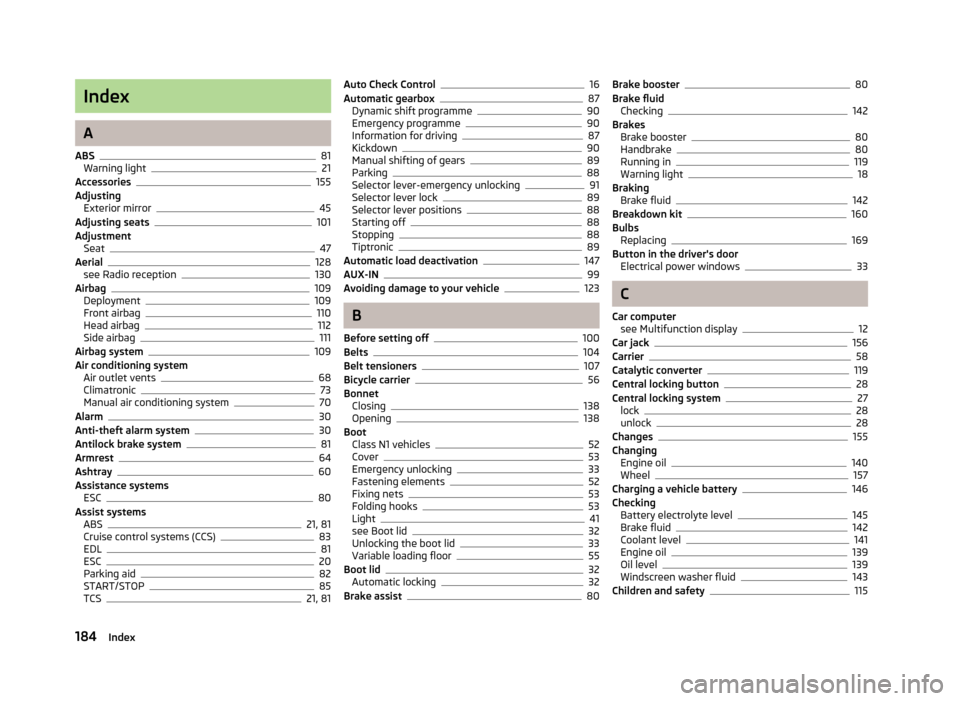
Index
A
ABS 81
Warning light 21
Accessories 155
Adjusting Exterior mirror 45
Adjusting seats 101
Adjustment Seat 47
Aerial 128
see Radio reception 130
Airbag 109
Deployment 109
Front airbag 110
Head airbag 112
Side airbag 111
Airbag system 109
Air conditioning system Air outlet vents 68
Climatronic 73
Manual air conditioning system 70
Alarm 30
Anti-theft alarm system 30
Antilock brake system 81
Armrest 64
Ashtray 60
Assistance systems ESC 80
Assist systems ABS 21, 81
Cruise control systems (CCS) 83
EDL 81
ESC 20
Parking aid 82
START/STOP 85
TCS 21, 81Auto Check Control 16
Automatic gearbox 87
Dynamic shift programme 90
Emergency programme 90
Information for driving 87
Kickdown 90
Manual shifting of gears 89
Parking 88
Selector lever-emergency unlocking 91
Selector lever lock 89
Selector lever positions 88
Starting off 88
Stopping 88
Tiptronic 89
Automatic load deactivation 147
AUX-IN 99
Avoiding damage to your vehicle 123
B
Before setting off 100
Belts 104
Belt tensioners 107
Bicycle carrier 56
Bonnet Closing 138
Opening 138
Boot Class
N1 vehicles 52
Cover 53
Emergency unlocking 33
Fastening elements 52
Fixing nets 53
Folding hooks 53
Light 41
see Boot lid 32
Unlocking the boot lid 33
Variable loading floor 55
Boot lid 32
Automatic locking 32
Brake assist 80Brake booster 80
Brake fluid Checking 142
Brakes Brake booster 80
Handbrake 80
Running in 119
Warning light 18
Braking Brake fluid 142
Breakdown kit 160
Bulbs Replacing 169
Button in the driver's door Electrical power windows 33
C
Car computer see Multifunction display 12
Car jack 156
Carrier 58
Catalytic converter 119
Central locking button 28
Central locking system 27
lock 28
unlock 28
Changes 155
Changing Engine oil 140
Wheel 157
Charging a vehicle battery 146
Checking Battery electrolyte level 145
Brake fluid 142
Coolant level 141
Engine oil 139
Oil level 139
Windscreen washer fluid 143
Children and safety 115
184 Index
Page 188 of 194
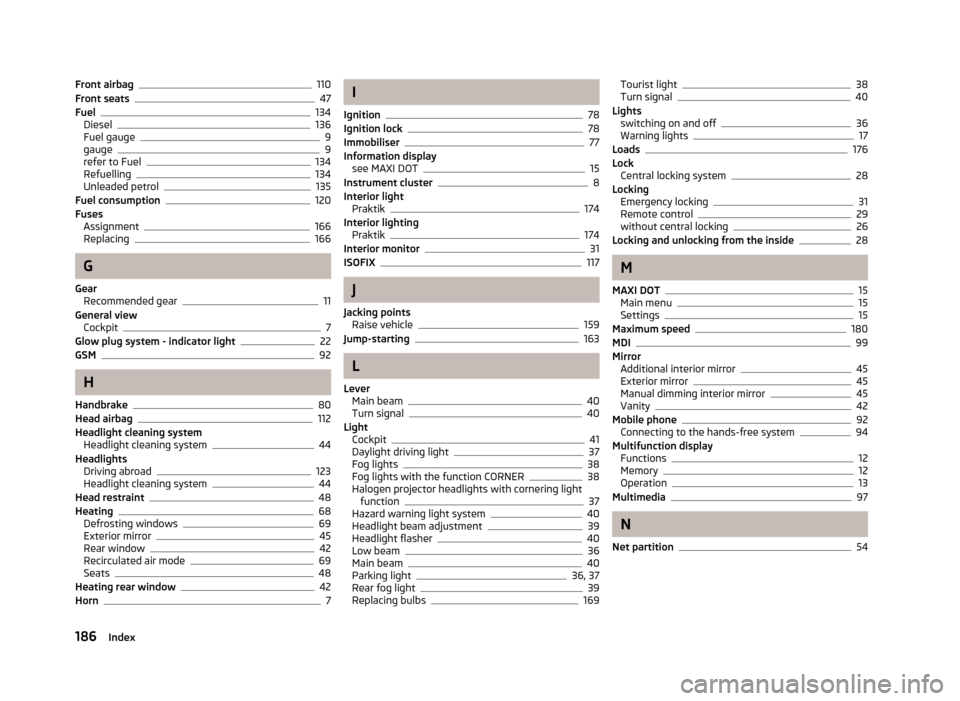
Front airbag 110
Front seats 47
Fuel 134
Diesel 136
Fuel gauge 9
gauge 9
refer to Fuel 134
Refuelling 134
Unleaded petrol 135
Fuel consumption 120
Fuses Assignment 166
Replacing 166
G
Gear Recommended gear 11
General view Cockpit 7
Glow plug system - indicator light 22
GSM 92
H
Handbrake 80
Head airbag 112
Headlight cleaning system Headlight cleaning system 44
Headlights Driving abroad 123
Headlight cleaning system 44
Head restraint 48
Heating 68
Defrosting windows 69
Exterior mirror 45
Rear window 42
Recirculated air mode 69
Seats 48
Heating rear window 42
Horn 7 I
Ignition 78
Ignition lock 78
Immobiliser 77
Information display see MAXI DOT 15
Instrument cluster 8
Interior light Praktik 174
Interior lighting Praktik 174
Interior monitor 31
ISOFIX 117
J
Jacking points Raise vehicle 159
Jump-starting 163
L
Lever Main beam 40
Turn signal 40
Light Cockpit 41
Daylight driving light 37
Fog lights 38
Fog lights with the function CORNER 38
Halogen projector headlights with cornering light function 37
Hazard warning light system 40
Headlight beam adjustment 39
Headlight flasher 40
Low beam 36
Main beam 40
Parking light 36, 37
Rear fog light 39
Replacing bulbs 169Tourist light 38
Turn signal 40
Lights switching on and off 36
Warning lights 17
Loads 176
Lock Central locking system 28
Locking Emergency locking 31
Remote control 29
without central locking 26
Locking and unlocking from the inside 28
M
MAXI DOT 15
Main menu 15
Settings 15
Maximum speed 180
MDI 99
Mirror Additional interior mirror 45
Exterior mirror 45
Manual dimming interior mirror 45
Vanity 42
Mobile phone 92
Connecting to the hands-free system 94
Multifunction display Functions 12
Memory 12
Operation 13
Multimedia 97
N
Net partition 54
186 Index
Page 189 of 194
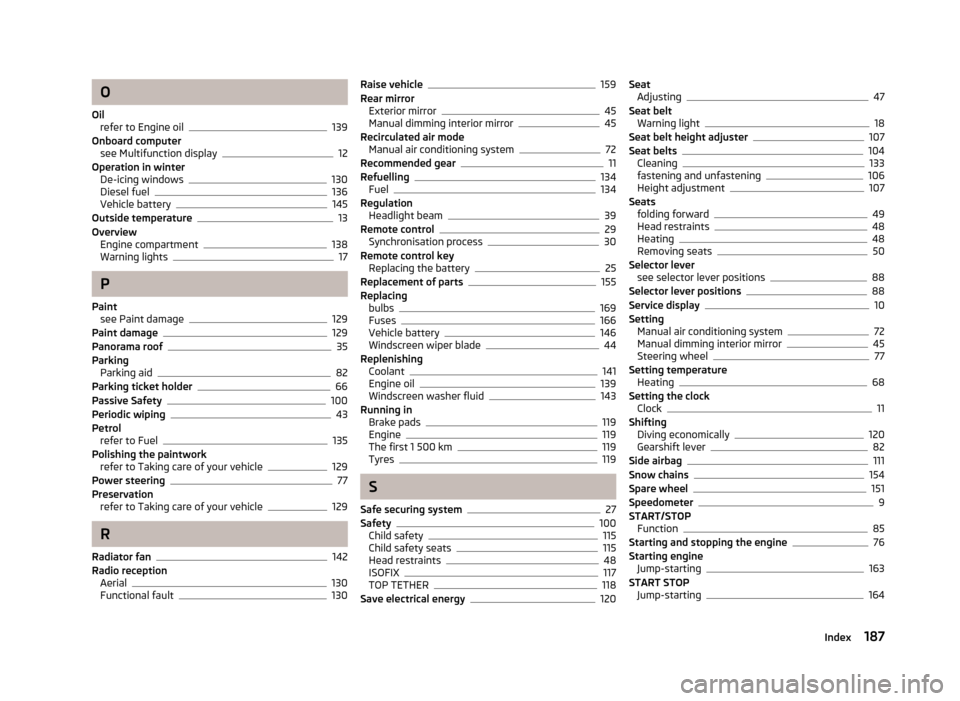
O
Oil refer to Engine oil 139
Onboard computer see Multifunction display 12
Operation in winter De-icing windows 130
Diesel fuel 136
Vehicle battery 145
Outside temperature 13
Overview Engine compartment 138
Warning lights 17
P
Paint see Paint damage 129
Paint damage 129
Panorama roof 35
Parking Parking aid 82
Parking ticket holder 66
Passive Safety 100
Periodic wiping 43
Petrol refer to Fuel 135
Polishing the paintwork refer to Taking care of your vehicle 129
Power steering 77
Preservation refer to Taking care of your vehicle 129
R
Radiator fan 142
Radio reception Aerial 130
Functional fault 130Raise vehicle 159
Rear mirror Exterior mirror 45
Manual dimming interior mirror 45
Recirculated air mode Manual air conditioning system 72
Recommended gear 11
Refuelling 134
Fuel 134
Regulation Headlight beam 39
Remote control 29
Synchronisation process 30
Remote control key Replacing the battery 25
Replacement of parts 155
Replacing bulbs 169
Fuses 166
Vehicle battery 146
Windscreen wiper blade 44
Replenishing Coolant 141
Engine oil 139
Windscreen washer fluid 143
Running in Brake pads 119
Engine 119
The first 1 500 km 119
Tyres 119
S
Safe securing system 27
Safety 100
Child safety 115
Child safety seats 115
Head restraints 48
ISOFIX 117
TOP TETHER 118
Save electrical energy 120Seat
Adjusting 47
Seat belt Warning light 18
Seat belt height adjuster 107
Seat belts 104
Cleaning 133
fastening and unfastening 106
Height adjustment 107
Seats folding forward 49
Head restraints 48
Heating 48
Removing seats 50
Selector lever see selector lever positions 88
Selector lever positions 88
Service display 10
Setting Manual air conditioning system 72
Manual dimming interior mirror 45
Steering wheel 77
Setting temperature Heating 68
Setting the clock Clock 11
Shifting Diving economically 120
Gearshift lever 82
Side airbag 111
Snow chains 154
Spare wheel 151
Speedometer 9
START/STOP Function 85
Starting and stopping the engine 76
Starting engine Jump-starting 163
START STOP Jump-starting 164
187
Index